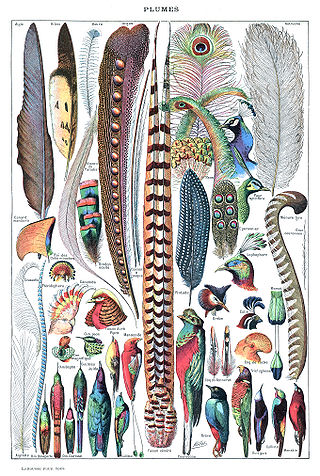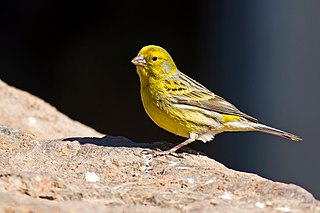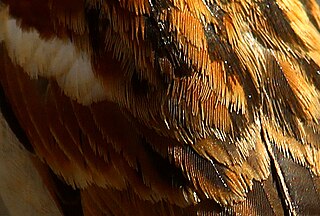
The red factor canary [1] is a variety of domestic canary, named after its colorful plumage. It is a bird commonly kept as a pet and for showing.

The red factor canary [1] is a variety of domestic canary, named after its colorful plumage. It is a bird commonly kept as a pet and for showing.
The red factor canary averages about 5+1⁄2 inches (14 cm) in length. This variety of canary tends to be bred for the novelty of its color, rather than for its song.
It was developed as a cross between another type of finch — the now-endangered Venezuelan red siskin ( Spinus cucullatus ) — and a yellow domestic canary (Serinus canariadomestica). [2] [3]
In breeding/showing, domestic canaries are broken down into two types based on pigmentation: melanics [4] and lipochromes. [5] Melanics contain melanin markings over top of lipochromes in their feathers, while lipochrome canaries have feathers that contain no melanin in their pigmentation. The red factor canary is classified as a lipochrome.
There are two types of red factor canaries based on the lipochrome distribution in their plumage: intensive red factors and non-intensive red factors. Intensive red factors are characterized by even lipochrome distribution throughout their feathers, giving the plumage a bright and uniform appearance throughout. Birds with non-intensive coloration have feathers that lack pigmentation at the tips — referred to as frosting due to the appearance — this makes for a more subdued brightness in appearance than birds with intensive coloration.
Red factor canaries are usually available at most pet stores and can also be found through bird shows, bird clubs, breeders and on the internet.

Melanin is a family of biomolecules organized as oligomers or polymers, which among other functions provide the pigments of many organisms. Melanin pigments are produced in a specialized group of cells known as melanocytes.

Feathers are epidermal growths that form a distinctive outer covering, or plumage, on both avian (bird) and some non-avian dinosaurs and other archosaurs. They are the most complex integumentary structures found in vertebrates and an example of a complex evolutionary novelty. They are among the characteristics that distinguish the extant birds from other living groups.

The Atlantic canary, known worldwide simply as the wild canary and also called the island canary, common canary, or canary, is a small passerine bird belonging to the genus Serinus in the true finch family, Fringillidae. It is native to the Canary Islands, the Azores, and Madeira. It has two subspecies: the wild or common canary and domestic canary. Wild birds are mostly yellow-green, with brownish streaking on the back. The species is common in captivity and a number of colour varieties have been bred.

The rock dove, rock pigeon, or common pigeon is a member of the bird family Columbidae. In common usage, it is often simply referred to as the "pigeon", although this is the wild form of the bird; the pigeons most familiar to people are the domesticated form of the wild rock dove.

The red-winged blackbird is a passerine bird of the family Icteridae found in most of North America and much of Central America. It breeds from Alaska and Newfoundland south to Florida, the Gulf of Mexico, Mexico, and Guatemala, with isolated populations in western El Salvador, northwestern Honduras, and northwestern Costa Rica. It may winter as far north as Pennsylvania and British Columbia, but northern populations are generally migratory, moving south to Mexico and the Southern United States. Claims have been made that it is the most abundant living land bird in North America, as bird-counting censuses of wintering red-winged blackbirds sometimes show that loose flocks can number in excess of a million birds per flock and the full number of breeding pairs across North and Central America may exceed 250 million in peak years. It also ranks among the best-studied wild bird species in the world. The red-winged blackbird is sexually dimorphic; the male is all black with a red shoulder and yellow wing bar, while the female is a nondescript dark brown. Seeds and insects make up the bulk of the red-winged blackbird's diet.

Cat coat genetics determine the coloration, pattern, length, and texture of feline fur. The variations among cat coats are physical properties and should not be confused with cat breeds. A cat may display the coat of a certain breed without actually being that breed. For example, a Neva Masquerade could wear point coloration, the stereotypical coat of a Siamese.

Melanism is the congenital excess of melanin in an organism resulting in dark pigment.

Plumage is a layer of feathers that covers a bird and the pattern, colour, and arrangement of those feathers. The pattern and colours of plumage differ between species and subspecies and may vary with age classes. Within species, there can be different colour morphs. The placement of feathers on a bird is not haphazard but rather emerges in organized, overlapping rows and groups, and these feather tracts are known by standardized names.

The domestic pigeon is a pigeon subspecies that was derived from the rock dove or rock pigeon. The rock pigeon is the world's oldest domesticated bird. Mesopotamian cuneiform tablets mention the domestication of pigeons more than 5,000 years ago, as do Egyptian hieroglyphics. Pigeons were most likely domesticated in the Mediterranean at least 2000–5000 years ago, and may have been domesticated earlier as a food source. Research suggests that domestication of pigeons occurred as early as 10,000 years ago.

Industrial melanism is an evolutionary effect prominent in several arthropods, where dark pigmentation (melanism) has evolved in an environment affected by industrial pollution, including sulphur dioxide gas and dark soot deposits. Sulphur dioxide kills lichens, leaving tree bark bare where in clean areas it is boldly patterned, while soot darkens bark and other surfaces. Darker pigmented individuals have a higher fitness in those areas as their camouflage matches the polluted background better; they are thus favoured by natural selection. This change, extensively studied by Bernard Kettlewell (1907–1979), is a popular teaching example in Darwinian evolution, providing evidence for natural selection. Kettlewell's results have been challenged by zoologists, creationists and the journalist Judith Hooper, but later researchers have upheld Kettlewell's findings.

The domestic canary, often simply known as the canary, is a domesticated form of the wild canary, a small songbird in the finch family originating from the Macaronesian Islands of the Azores, Madeira and the Canary Islands.

Amelanism is a pigmentation abnormality characterized by the lack of pigments called melanins, commonly associated with a genetic loss of tyrosinase function. Amelanism can affect fish, amphibians, reptiles, birds, and mammals including humans. The appearance of an amelanistic animal depends on the remaining non-melanin pigments. The opposite of amelanism is melanism, a higher percentage of melanin.

Psittacofulvin pigments, sometimes called psittacins, are responsible for the bright-red, orange, and yellow colors specific to parrots. In parrots, psittacofulvins are synthesized by a polyketide synthase enzyme that is expressed in growing feathers. They consist of linear polyenes terminated by an aldehyde group. There are five known psittacofulvin pigments - tetradecahexenal, hexadecaheptenal, octadecaoctenal and eicosanonenal, in addition to a fifth, currently-unidentified pigment found in the feathers of scarlet macaws. Colorful feathers with high levels of psittacofulvin resist feather-degrading Bacillus licheniformis better than white ones.

The melanocortin 1 receptor (MC1R), also known as melanocyte-stimulating hormone receptor (MSHR), melanin-activating peptide receptor, or melanotropin receptor, is a G protein–coupled receptor that binds to a class of pituitary peptide hormones known as the melanocortins, which include adrenocorticotropic hormone (ACTH) and the different forms of melanocyte-stimulating hormone (MSH). It is coupled to Gαs and upregulates levels of cAMP by activating adenylyl cyclase in cells expressing this receptor. It is normally expressed in skin and melanocytes, and to a lesser degree in periaqueductal gray matter, astrocytes and leukocytes. In skin cancer, MC1R is highly expressed in melanomas but not carcinomas.

Turacoverdin is a unique copper uroporphyrin pigment responsible for the bright green coloration of several birds of the family Musophagidae, most notably the turaco. It is chemically related to turacin, a red pigment also found almost exclusively in turacos. Turacoverdin is one of the only true green pigments found in birds, as the coloration that appears in most green feathers is due to the unique properties of blue structural coloration in combination with yellow carotenoids. Turacoverdin and turacin were the first ever chemically characterized feather pigments, and turacoverdin was first isolated and described in 1882 by Dr. C.F.W. Krukenberg.

Solid black plumage color refers to a plumage pattern in chickens characterized by a uniform, black color across all feathers. There are chicken breeds where the typical plumage color is black, such as Australorp, Sumatra, White-Faced Black Spanish, Jersey Giant and others. And there are many other breeds having different color varieties, which also have an extended black variety, such as Leghorn, Minorca, Wyandotte, Orpington, Langshan and others.

In poultry standards, solid white is coloration of plumage in chickens characterized by a uniform pure white color across all feathers, which is not generally associated with depigmentation in any other part of the body.

Sexual selection in birds concerns how birds have evolved a variety of mating behaviors, with the peacock tail being perhaps the most famous example of sexual selection and the Fisherian runaway. Commonly occurring sexual dimorphisms such as size and color differences are energetically costly attributes that signal competitive breeding situations. Many types of avian sexual selection have been identified; intersexual selection, also known as female choice; and intrasexual competition, where individuals of the more abundant sex compete with each other for the privilege to mate. Sexually selected traits often evolve to become more pronounced in competitive breeding situations until the trait begins to limit the individual's fitness. Conflicts between an individual fitness and signaling adaptations ensure that sexually selected ornaments such as plumage coloration and courtship behavior are "honest" traits. Signals must be costly to ensure that only good-quality individuals can present these exaggerated sexual ornaments and behaviors.

Albinism is the congenital absence of melanin in an animal or plant resulting in white hair, feathers, scales and skin and reddish pink or blue eyes. Individuals with the condition are referred to as albinos.

The Catalina macaw, sometimes known as the rainbow macaw is a first generation hybrid between the blue-and-gold macaw and scarlet macaw. As catalina macaws are hybrids, they do not have a true scientific name. The best way to represent these birds in taxonomy is by the expression Ara ararauna × Ara macao.